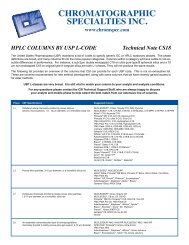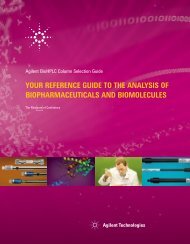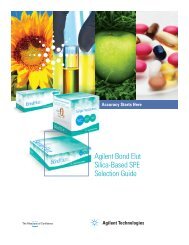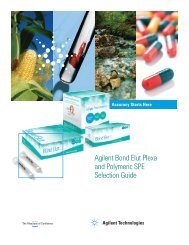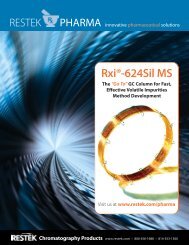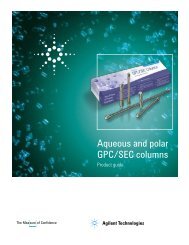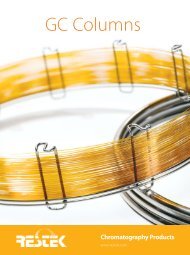Optimizing the Analysis of Volatile Organic Compounds
Optimizing the Analysis of Volatile Organic Compounds
Optimizing the Analysis of Volatile Organic Compounds
You also want an ePaper? Increase the reach of your titles
YUMPU automatically turns print PDFs into web optimized ePapers that Google loves.
54<br />
1. dichlorodifluoromethane<br />
2. chloromethane<br />
3. vinyl chloride<br />
4. bromomethane<br />
5. chloroethane<br />
6. trichlor<strong>of</strong>luoromethane<br />
7. diethyl e<strong>the</strong>r<br />
8. 1,1-dichloroe<strong>the</strong>ne<br />
9. carbon disulfide (40ppb)<br />
10. iodomethane (40ppb)<br />
11. allyl chloride<br />
12. methylene chloride<br />
13. acetone<br />
14. trans-1,2-dichloroe<strong>the</strong>ne<br />
15. methyl tert-butyl e<strong>the</strong>r<br />
16. 1,1-dichloroethane<br />
17. acrylonitrile<br />
18. cis-1,2-dichloroe<strong>the</strong>ne<br />
www.restekcorp.com<br />
Figure 50.<br />
<strong>Volatile</strong> <strong>Organic</strong>s by US EPA Method 524.2, rev. IV. A 30m x 0.25mm ID column and<br />
11 minute analysis provide excellent resolution <strong>of</strong> gaseous VOAs.<br />
30m, 0.25mm ID, 1.4 m Rtx fi -VMS (cat.# 19915)<br />
Carrier gas: helium @ ~1.3mL/min. constant flow<br />
Adjust dichlorodifluoromethane to a retention time <strong>of</strong> 2.29 min. @ 45 C<br />
Concentrator: Tekmar LSC-3000 Purge and Trap<br />
Oven temp.: 45 C (hold 2 min.) to 85 C @ 14 C/min. to<br />
210 C @ 40 C/min. (hold 4 min.)<br />
GC: Agilent 6890 Series II<br />
Trap: Vocarb 3000<br />
Purge: 11 min. @ 40mL/min.<br />
Dry purge: 1 min. @ 40mL/min. (MCS bypassed)<br />
Desorb preheat: 245 C<br />
Desorb: 250 C for 2 min.<br />
Bake: 260 C for 8 min.<br />
Interface: 1:10 split in port<br />
Transfer line: 5m, 0.32mm ID Siltek tubing (cat.# 10027)<br />
Detector: Agilent 5973 MSD<br />
Scan range: 35-300amu<br />
Standards:<br />
20ppb in 5mL <strong>of</strong> RO water (unless o<strong>the</strong>rwise noted); ketones at 40ppb.<br />
502.2 Cal Mix #1 (cat.# 30042)<br />
502.2 Cal2000 MegaMix (cat.# 30431)<br />
524 Cal Mix 7A & 7B (cat.# 30202)<br />
524 Cal Mix #8 (cat.# 30203)<br />
524 IS/SS Mix (cat.# 30201)<br />
1<br />
3<br />
2<br />
4<br />
5<br />
6<br />
7<br />
9<br />
8<br />
10<br />
11<br />
12,<br />
13 14<br />
15<br />
16,17<br />
2 3 4 5 6 7 8 9 10 11<br />
19. 2,2-dichloropropane<br />
20. bromochloromethane<br />
21. chlor<strong>of</strong>orm<br />
22. methyl acrylate<br />
23. carbon tetrachloride<br />
24. tetrahydr<strong>of</strong>uran (40ppb)<br />
25. 1,1,1-trichloroethane<br />
26. 2-butanone<br />
27. 1,1-dichloropropene<br />
28. 1-chlorobutane<br />
29. benzene<br />
30. propionitrile<br />
31. 1,2-dichloroethane<br />
32. fluorobenzene<br />
33. trichloroe<strong>the</strong>ne<br />
34. dibromomethane<br />
35. 1,2-dichloropropane<br />
36. bromodichloromethane<br />
*These compounds share a quantitation ion (43)<br />
25,26<br />
27,28<br />
23,24<br />
20,21<br />
18 19 22<br />
29,30<br />
31<br />
32<br />
33 35,36<br />
34<br />
37<br />
44,45<br />
39,40<br />
46<br />
38<br />
43<br />
*<br />
41,<br />
42<br />
37. methyl methacrylate<br />
38. cis-1,3-dichloropropene<br />
39. toluene<br />
40. chloroacetonitrile<br />
41. 2-nitropropane*<br />
42. 1,1-dichloropropanone*<br />
43. 4-methyl-2-pentanone<br />
44. tetrachloroe<strong>the</strong>ne<br />
45. trans-1,3-dichloropropene<br />
46. ethyl methacrylate<br />
47. 1,1,2-trichloroethane<br />
48. dibromochloromethane<br />
49. 1,3-dichloropropane<br />
50. 1,2-dibromoethane<br />
51. 2-hexanone<br />
52. ethylbenzene<br />
53. chlorobenzene<br />
54. 1,1,1,2-tetrachloroethane<br />
52,53,54<br />
4749<br />
51<br />
48<br />
50<br />
55,56<br />
66,67,68<br />
63,64<br />
57,58 65<br />
60<br />
62<br />
70<br />
61<br />
59<br />
71,72<br />
69<br />
73<br />
74<br />
75 76<br />
78,79,80<br />
77<br />
55. m-xylene<br />
56. p-xylene<br />
57. o-xylene<br />
58. styrene<br />
59. brom<strong>of</strong>orm<br />
60. isopropylbenzene<br />
61. 4-brom<strong>of</strong>luorobenzene<br />
62. n-propylbenzene<br />
63. bromobenzene<br />
64. 1,1,2,2-tetrachloroethane<br />
65. 1,3,5-trimethylbenzene<br />
66. 2-chlorotoluene<br />
67. 1,2,3-trichloropropane<br />
68. trans-1,4-dichloro-2-butene<br />
69. 4-chlorotoluene<br />
70. tert-butylbenzene<br />
71. 1,2,4-trimethylbenzene<br />
72. pentachloroethane<br />
81<br />
82,83<br />
84<br />
85<br />
86<br />
73. sec-butylbenzene<br />
74. p-isopropyltoluene<br />
75. 1,3-dichlorobenzene<br />
76. 1,4-dichlorobenzene<br />
77. n-butylbenzene<br />
78. hexachloroethane<br />
79. 1,2-dichlorobenzene-d4<br />
80. 1,2-dichlorobenzene<br />
81. 1,2-dibromo-3-chloropropane<br />
82. nitrobenzene<br />
83. hexachlorobutadiene<br />
84. 1,2,4-trichlorobenzene<br />
85. naphthalene<br />
86. 1,2,3-trichlorobenzene<br />
GC_EV00430<br />
Method 524.2: In EPA method updates, such as Method 524.2, rev. IV, minor ions from newly listed target compounds interfere with <strong>the</strong><br />
quantification ions from o<strong>the</strong>r target compounds. 17 An example <strong>of</strong> this problem occurs when a 75m, 0.53mm ID “624/1301” column is used<br />
to resolve methyl acrylate and propionitrile. The quantification ion for methyl acrylate is mass 55, and propionitrile has a minor ion <strong>of</strong> mass<br />
55, which thus can interfere with determining concentrations <strong>of</strong> methyl acrylate in “real world” samples. 1,1-dichloro-2-propanone and 4methyl-2-pentanone<br />
are ano<strong>the</strong>r difficult pair to resolve on a “624/1301” column, because <strong>the</strong>y share ion 43. These compounds can be<br />
resolved (in more than 30 minutes), however, by using a 60m, 0.32mm ID column. Because Rtx ® -VMS columns were designed to resolve<br />
compounds by primary quantification ion, using extracted ion chromatography (Figure 50), <strong>the</strong> only compounds from Method 524.2, rev. IV,<br />
that are difficult for an Rtx ® -VMS column to resolve are 2-nitropropane and 1,1-dichloro-2-propanone, (peaks 41 and 42) which share ion 43.<br />
17. Methods for <strong>the</strong> Determination <strong>of</strong> <strong>Organic</strong> <strong>Compounds</strong> in Drinking Water, Supplement II Method 524.2: U.S. Environmental Protection Agency, Office <strong>of</strong><br />
Research and Development, Environmental Monitoring Systems Laboratory, Cinncinnati, OH. 1992.





